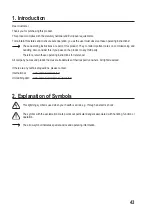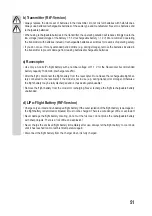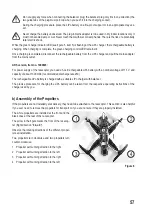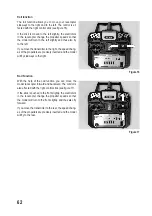
48
b) Mains Unit
• The mains unit is constructed pursuant to protection class II.
• Use only a proper mains socket of the public supply mains for voltage/current supply of the plug-in mains
unit.
• The mains socket to which the mains unit is connected must be easily accessible.
• Do not pull the mains adapter from the mains socket by pulling the cable. Always take it by the side of the
housing and pull it from the socket straight.
• Protect the plug-in mains unit from moisture and wetness as well as from damage. If the plug-in mains unit
has become moist or wet or damaged, do not touch it. Danger to life from electric shock!
First deactivate all sides of the mains socket to which the plug-in mains unit is connected (e.g. switch off
the respective fuse or turn out the fuse. Then deactivate the FI protection switch). Only then pull the plug-
in mains unit from the mains socket; no longer use the plug-in charger, but dispose of it environmentally
compatibly.
c) Charger
• The charger must not become damp or wet. Also do not place any containers filled with liquid, vases or
plants, on or next to the charger.
When these liquids get into the charger, the charger will be destroyed and there is a considerable fire
hazard.
• The charger is only suitable for charging 2- or 3-cell LiPo battery packs. Never charge more than one
rechargeable battery at the same time. Never charge any other rechargeable battery types or non-re-
chargeable batteries. There is great danger of fire or explosion!
• The charger is intended for dry indoor use only. It must not become damp or wet. Avoid direct sun irradia
-
tion, strong heat or cold. Keep the charger away from dust and dirt.
• Never place the charger on a flammable surface (e.g. carpet, tablecloth). Always use a suitable, non-
flammable, heatproof surface. Never cover the charger. Keep the charger away from flammable or easily
inflammable materials (e.g. curtains).
• Do not place the charger on any valuable furniture surfaces without using suitable protection. Otherwise,
scratches, pressure points or discolourations are possible.
• Do not use the charger inside a vehicle.
• Keep children away from the charger. Children may short-circuit the rechargeable battery, which may lead
to fire or explosion. Danger to life!
• Avoid operation in direct proximity of strong magnetic or electromagnetic fields, transmitter aerials or HF
generators. This can affect the control electronics.
• Never charge the rechargeable battery unsupervised in the charger.
• Do not wear any metal or conductive materials, such as jewellery (necklaces, bracelets, rings, etc.) while
you are working with the charger or batteries. Short-circuit poses a danger of burns and explosion.
• Never operate the charger immediately after it has been taken from a cold room to a warm room. The
resulting condensation may lead to malfunctions or damage!
Allow the charger to reach room temperature before connecting and operating it. This may take several
hours!













































